JVC GR-AX410, GR-AX310 User Manual
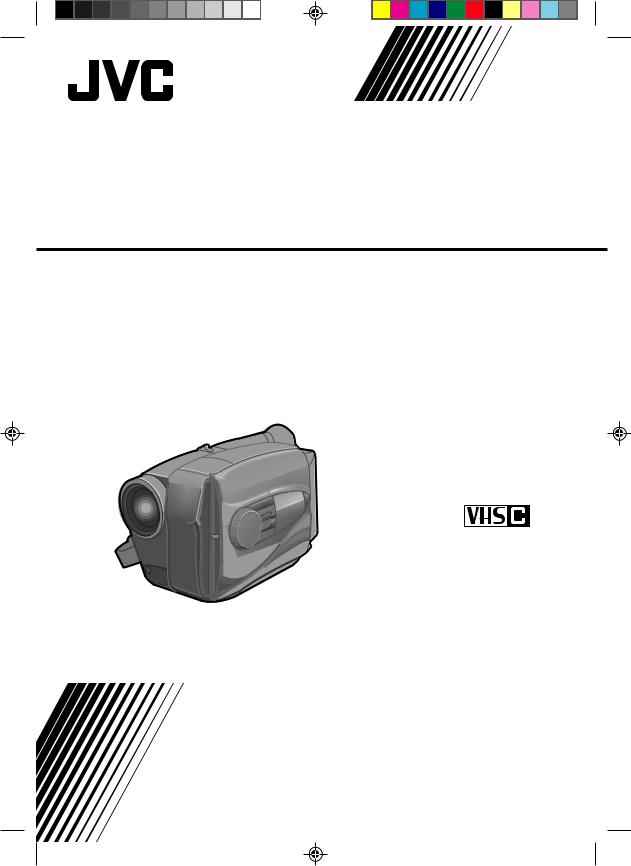
COMPACT VHS CAMCORDER
CAMESCOPE COMPACT VHS
GR-AX210
GR-AX310
GR-AX410
Compact VHS
(The camcorder illustrations appearing in these instructions are of the GR-AX310.)
INSTRUCTIONS
MANUEL D'INSTRUCTIONS
YU30052-515-1
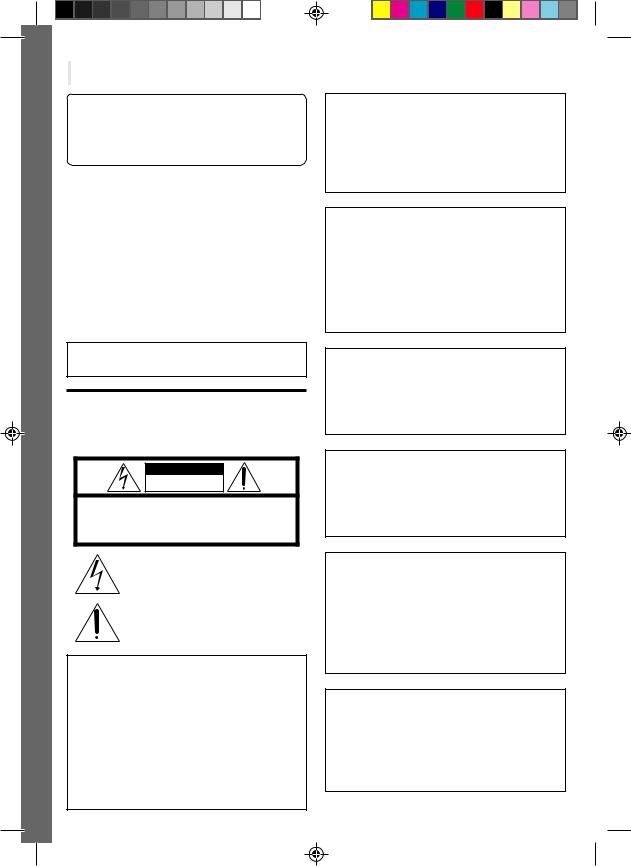
2










































































Dear Customer,
Thank you for purchasing the JVC Compact VHS camcorder. Before use, please read the safety information and precautions contained in the following pages to ensure safe use of your new camcorder.
Using This Instruction Manual
•All major sections and subsections are listed in the Table Of Contents (Z pg. 7).
•Notes appear after most subsections. Be sure to read these as well.
•Basic and advanced features/operation are separated for easier reference.
It is recommended that you . . .
..... refer to the Index (Z pgs. 40 – 42) and
familiarize yourself with button locations, etc. before use.
..... read thoroughly the Safety Precautions and Safety Instructions that follow. They contain extremely important information regarding the safe use of your new camcorder.
You are recommended to carefully read the cautions on pages 43 and 44 before use.
SAFETY PRECAUTIONS
WARNING:
TO PREVENT FIRE OR SHOCK HAZARD, DO NOT EXPOSE THIS UNIT TO RAIN OR MOISTURE.
Warning on lithium battery
The battery used in this device may present a fire or chemical burn hazard if mistreated. Do not recharge, disassemble, heat above 100°C (212°F) or incinerate. Replace the battery with Panasonic (Matsushita Electric), Sanyo or Maxell CR2025; use of another battery may present a risk of fire or explosion.
nDispose of used battery promptly.
nKeep away from children.
nDo not disassemble and do not dispose of in fire.
NOTES:
cThe rating plate (serial number plate) and safety caution are on the bottom and/or the back of the main unit.
cThe rating plate (serial number plate) of the AC Power Adapter/Charger is on its bottom.
CAUTION
RISK OF ELECTRIC SHOCK
DO NOT OPEN
CAUTION: TO REDUCE THE RISK OF ELECTRIC SHOCK.
DO NOT REMOVE COVER (OR BACK). NO USER-SERVICEABLE PARTS INSIDE.
REFER SERVICING TO QUALIFIED SERVICE PERSONNEL.
The lightning flash with arrowhead symbol, within an equilateral triangle, is intended to alert the user to the presence of uninsulated "dangerous voltage" within the product's enclosure that may be of sufficient magnitude to constitute a risk of electric shock to persons.
The exclamation point within an equilateral triangle is intended to alert the user to the presence of important operating and maintenance (servicing) instructions in the literature accompanying the appliance.
The AA-V11U AC Power Adapter/Charger should be used with:
AC 120 V`, 60 Hz in the USA and Canada, AC 110 – 240 V`, 50/60 Hz in other countries.
CAUTION (applies to the AA-V11U)
TO PREVENT ELECTRIC SHOCK MATCH WIDE BLADE OF PLUG TO WIDE SLOT, FULLY INSERT.
ATTENTION (s'applique à l'AA-V11U)
POUR ÉVITER LES CHOCS ÉLECTRIQUES, INTRODUIRE LA LAME LA PLUS LARGE DE LA FICHE DANS LA BORNE CORRESPONDANTE DE LA PRISE ET POUSSER JUSQU'AU FOND.
This Class B digital apparatus meets all requirements of the Canadian Interference – Causing Equipment Regulations.
Cet appareil numérique de la classe B respecte toutes les exigences du Règlement sur le matériel brouilleur du Canada.
This camcorder is designed to be used with NTSC-type color television signals. It cannot be used for playback with a television of a different standard. However, live recording and viewfinder playback are possible anywhere. Use the BN-V11U/V12U/V22U/V25U battery packs and, to recharge them, the provided multi-voltage AC Power Adapter/Charger. (An appropriate conversion adapter may be necessary to accommodate different designs of AC outlets in different countries.)
ATTENTION:
The product that you have purchased is powered by a rechargeable battery. The battery is recyclable. At the end of its useful life, under various state and local laws, it may be illegal to dispose of this battery into the municipal waste stream. Check with your local solid waste officials for details in your area for recycling options or proper disposal.
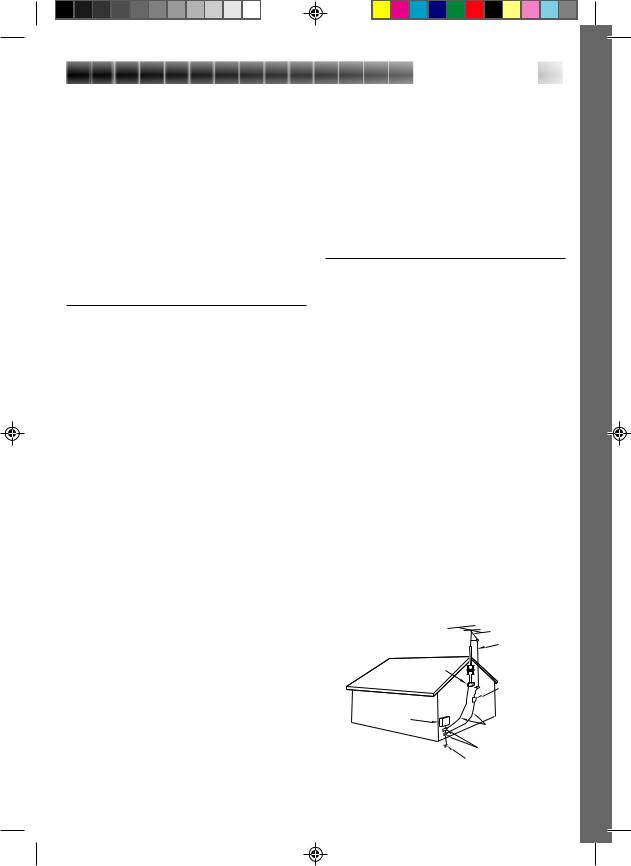
IMPORTANT PRODUCT SAFETY INSTRUCTIONS
Electrical energy can perform many useful functions. But improper use can result in potential electrical shock or fire hazards. This product has been engineered and manufactured to assure your personal safety. In order not to defeat the built-in safeguards, observe the following basic rules for its installation, use and servicing.
ATTENTION:
Follow and obey all warnings and instructions marked on your product and its operating instructions. For your safety, please read all the safety and operating instructions before you operate this product and keep this manual for future reference.
INSTALLATION
1. Grounding or Polarization
(A)Your product may be equipped with a polarized alternating-current line plug (a plug having one blade wider than the other). This plug will fit into the power outlet only one way. This is a safety feature.
If you are unable to insert the plug fully into the outlet, try reversing the plug. If the plug should still fail to fit, contact your electrician to replace your obsolete outlet. Do not defeat the safety purpose of the polarized plug.
(B)Your product may be equipped with a 3-wire grounding-type plug, a plug having a third (grounding) pin. This plug will only fit into a grounding-type power outlet. This is a safety feature.
If you are unable to insert the plug into the outlet, contact your electrician to replace your obsolete outlet. Do not defeat the safety purpose of the grounding-type plug.
2. Power Sources
Operate your product only from the type of power source indicated on the marking label. If you are not sure of the type of power supply to your home, consult your product dealer or local power company. If your product is intended to operate from battery power, or other sources, refer to the operating instructions.
3. Overloading
Do not overload wall outlets, extension cords, or integral convenience receptacles as this can result in a risk of fire or electric shock.
4. Power Cord Protection
Power supply cords should be routed so that they are not likely to be walked on or pinched by items placed upon or against them, paying particular attention to cords at plugs, convenience receptacles, and the point where they exit from the product.


 3
3
5. Ventilation
Slots and openings in the cabinet are provided for ventilation. To ensure reliable operation of the product and to protect it from overheating, these openings must not be blocked or covered.
•Do not block the openings by placing the product on a bed, sofa, rug or other similar surface.
•Do not place the product in a built-in installation such as a bookcase or rack unless proper ventilation is provided or the manufacturer’s instructions have been adhered to.
6. Wall or Ceiling Mounting
The product should be mounted to a wall or ceiling only as recommended by the manufacturer.
ANTENNA INSTALLATION
INSTRUCTIONS
1. Outdoor Antenna Grounding
If an outside antenna or cable system is connected to the product, be sure the antenna or cable system is grounded so as to provide some protection against voltage surges and built-up static charges. Article 810 of the National Electrical Code, ANSI/NFPA 70, provides information with regard to proper grounding of the mast and supporting structure, grounding of the lead-in wire to an antenna discharge unit, size of grounding conductors, location of antenna discharge unit, connection to grounding electrodes, and requirements for the grounding electrode.
2. Lightning
For added protection for this product during a lightning storm, or when it is left unattended and unused for long periods of time, unplug it from the wall outlet and disconnect the antenna or cable system. This will prevent damage to the product due to lightning and power-line surges.
3. Power Lines
An outside antenna system should not be located in the vicinity of overhead power lines or other electric light or power circuits, or where it can fall into such power lines or circuits. When installing an outside antenna system, extreme care should be taken to keep from touching such power lines or circuits as contact with them might be fatal.
EXAMPLE OF ANTENNA GROUNDING AS PER
NATIONAL ELECTRICAL CODE, ANSI/NFPA 70
|
ANTENNA |
|
LEAD IN WIRE |
GROUND CLAMP |
|
|
ANTENNA |
|
DISCHARGE UNIT |
|
(NEC SECTION |
ELECTRIC SERVICE |
810-20) |
EQUIPMENT |
GROUNDING |
|
|
|
CONDUCTORS |
|
(NEC SECTION 810-21) |
|
GROUND CLAMPS |
POWER SERVICE GROUNDING ELECTRODE SYSTEM |
|
(NEC ART 250. PART H) |
|
NEC – NATIONAL ELECTRICAL CODE |
|
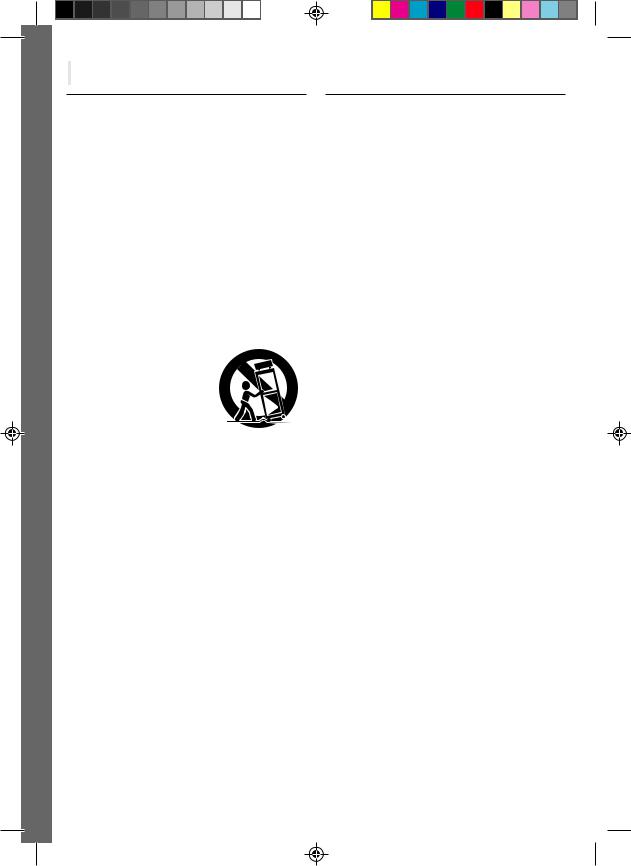
4










































































USE
1. Accessories
To avoid personal injury:
•Do not place this product on an unstable cart, stand, tripod, bracket or table. It may fall, causing serious injury to a child or adult, and serious damage to the product.
•Use only with a cart, stand, tripod, bracket, or table recommended by the manufacturer or sold with the product.
•Use a mounting accessory recommended by the manufacturer and follow the manufacturer’s instructions for any mounting of the product.
•Do not try to roll a cart with small casters across thresholds or deep-pile carpets.
2. Product and Cart Combination
A product and cart combination should be moved with care. Quick stops, excessive force, and uneven surfaces may cause the product and cart combination to overturn.
3. Water and Moisture
Do not use this product near water—for example, near a bath tub, wash bowl, kitchen sink or laundry tub, in a wet basement, or near a swimming pool and the like.
4. Object and Liquid Entry
PORTABLE CART WARNING (Symbol provided by RETAC)
Never push objects of any kind into this product through openings as they may touch dangerous voltage points or short-out parts that could result in a fire or electric shock. Never spill liquid of any kind on the product.
5. Attachments
Do not use attachments not recommended by the manufacturer of this product as they may cause hazards.
6. Cleaning
Unplug this product from the wall outlet before cleaning. Do not use liquid cleaners or aerosol cleaners. Use a damp cloth for cleaning.
7. Heat
The product should be situated away from heat sources such as radiators, heat registers, stoves, or other products (including amplifiers) that produce heat.
SERVICING
1. Servicing
If your product is not operating correctly or exhibits a marked change in performance and you are unable to restore normal operation by following the detailed procedure in its operating instructions, do not attempt to service it yourself as opening or removing covers may expose you to dangerous voltage or other hazards. Refer all servicing to qualified service personnel.
2. Damage Requiring Service
Unplug this product from the wall outlet and refer servicing to qualified service personnel under the following conditions:
a.When the power supply cord or plug is damaged.
b.If liquid has been spilled, or objects have fallen into the product.
c.If the product has been exposed to rain or water.
d.If the product does not operate normally by following the operating instructions. Adjust only those controls that are covered by the operating instructions as an improper adjustment of other controls may result in damage and will often require extensive work by a qualified technician to restore the product to its normal operation.
e.If the product has been dropped or damaged in any way.
f.When the product exhibits a distinct change in performance—this indicates a need for service.
3. Replacement Parts
When replacement parts are required, be sure the service technician has used replacement parts specified by the manufacturer or have the same characteristics as the original part. Unauthorized substitutions may result in fire, electric shock or other hazards.
4. Safety Check
Upon completion of any service or repairs to this product, ask the service technician to perform safety checks to determine that the product is in safe operating condition.
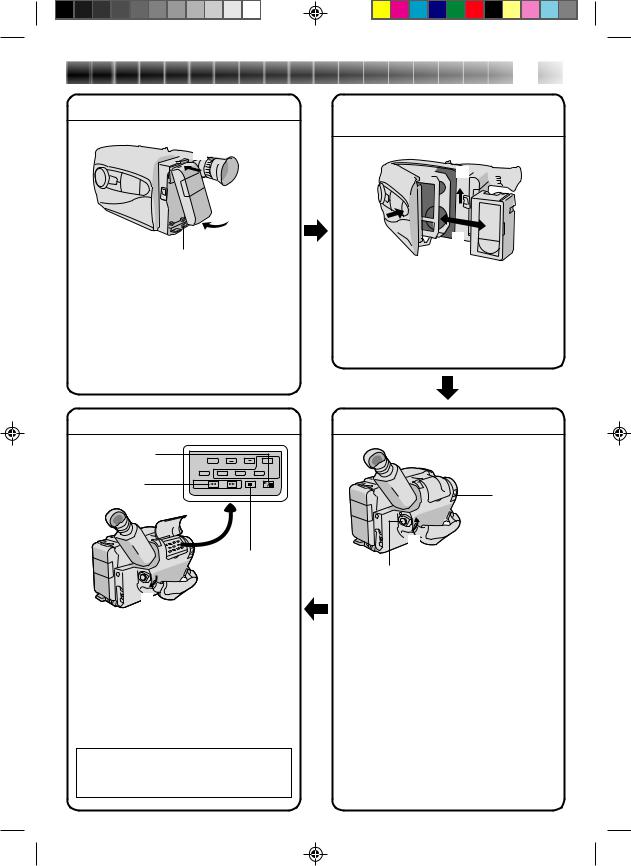
QUICK OPERATION GUIDE
SUPPLY POWER
Hook on.




 1
1
2Push in.
BATT. RELEASE
Using the battery pack
1Hook-on the battery pack’s top end to the camcorder. (Charging procedure, Z P. 8)
2Push in the battery pack until it locks into place.
To remove the battery pack
Slide BATT. RELEASE and pull out the battery pack.
 5
5
INSERTING A VIDEO
CASSETTE
EJECT



 1
1





3 |
|
PUSH |
2 |
|
|
|
Insert. |
1 Slide EJECT.
2 Insert a video cassette.
3 Press PUSH.
(For more details, Z P. 11)
PLAYBACK
3PLAY/PAUSE
2REW
STOP
1
Set to “PLAY”
1Set the power switch to “PLAY”.
2Press REW.
—The tape will automatically stop at the beginning of the tape.
3Press PLAY/PAUSE.
—Playback starts and the playback picture appears in the viewfinder.
•To stop playback, press STOP. (For more details, Z P. 30.)
nOr simply play back the tape on a VHS
VCR using the Cassette Adapter (VHS Playpak). Z P. 28
SHOOTING
1
LENS COVER open/close knob
2

Set to “CAMERA”
3Recording Start/Stop button
1 Slide the LENS COVER open/close knob to open the lens cover.
2 Set the power switch to “CAMERA”.
—The power indicator will light and an image will appear in the viewfinder.
3 Press the Recording Start/Stop button.
—Recording starts.
•To stop recording temporarily, momentarily press the Recording Start/Stop button once
again.
(For more details, Z P. 14)
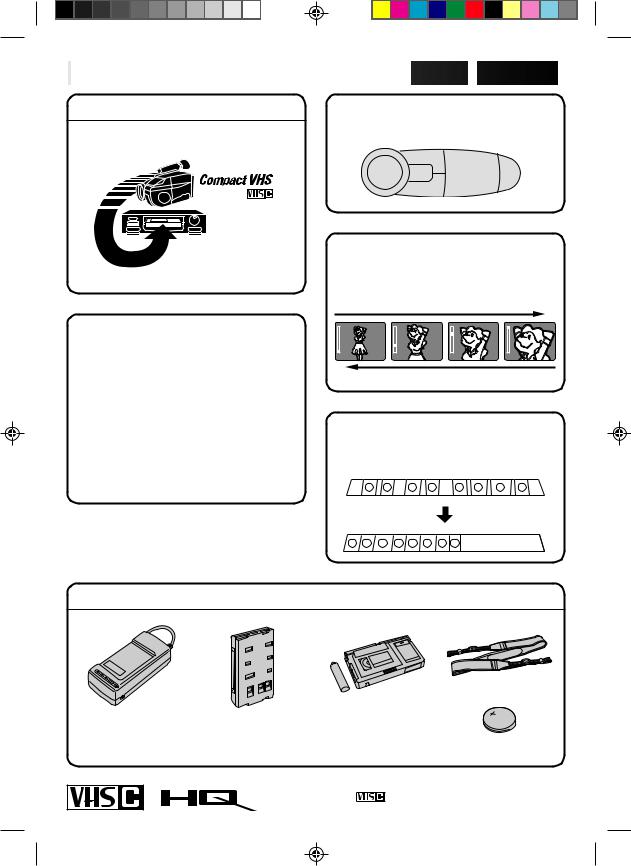
6
























































 MAJOR
MAJOR

 FEATURES
FEATURES
REMEMBER |
Intelligent Function Control |
The Logical Choice |
(Z P. 18 – 25) |
F1 |
|
|
SEL |
|
F2 |
 The only compact video cassettes that can be
The only compact video cassettes that can be
used with your VHS VCR*
*with VHS Playpak
Program AE with Special Effects (Z P. 16)
nAuto Mode Lock
nAuto Mode Release
nElectronic Fog Filter
nND Effect
nSepia
nTwilight
nSports
nHigh Speed (1/2000 sec.) Shutter
n15 sec. Self Timer
Variable-Speed Hyper Zoom [GR-AX210/AX410:12x, GR-AX310:14x] (Z P. 15)
Zoom-in
T |
T |
T |
T |
W |
W |
W |
W |
Zoom-out
Random Assemble Editing (Z P. 32 – 35)
[GR-AX310 only]
2 |
8 |
5 |
4 |
1 |
6 |
3 |
7 |
1 |
2 |
3 |
4 |
5 |
6 |
7 |
8 |
PROVIDED ACCESSORIES
|
|
|
|
•Shoulder Strap |
|
• AC Power Adapter/ |
•Battery Pack |
•Cassette Adapter |
|||
(VHS PlayPak) |
|||||
Charger AA-V11U |
BN-V11U |
|
|||
|
C-P7U |
•Lithium Battery |
|||
|
|
|
|||
|
|
Cassettes marked |
can be used with this camcorder. |
||
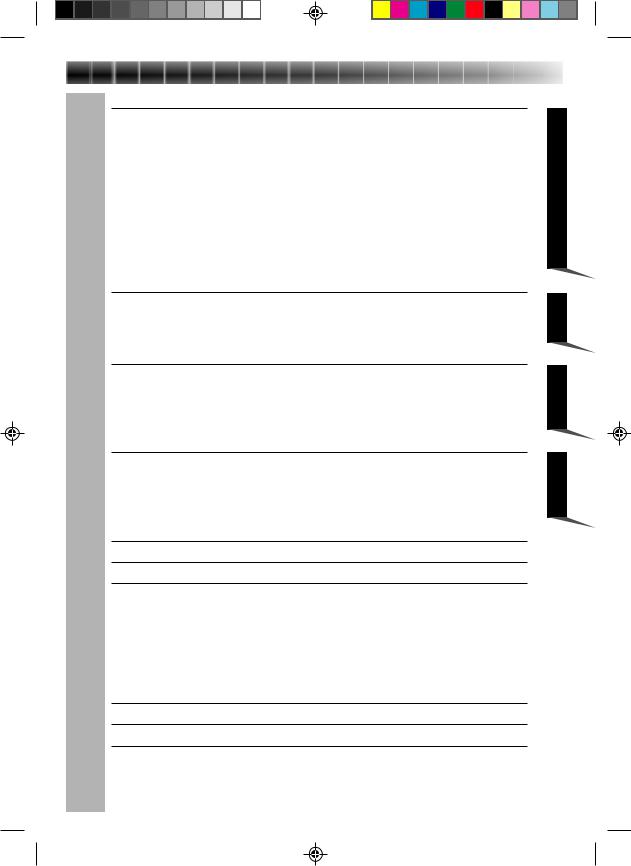
CONTENTS |
|
GETTING STARTED |
8 |
Power ..................................................................................... |
8 |
Clock (Lithium) Battery Removal/Insertion........................................ |
10 |
Date/Time Settings ................................................................... |
10 |
Viewfinder Adjustment ............................................................... |
11 |
Tape Length/Recording Mode Setting .............................................. |
11 |
Loading/Unloading A Cassette ...................................................... |
11 |
Grip Adjustment ....................................................................... |
12 |
Shoulder Strap Attachment........................................................... |
12 |
Tripod Mounting ....................................................................... |
12 |
RM-V20U Remote Control Unit ..................................................... |
13 |
RECORDING |
14 |
Basic Recording ........................................................................ |
14 |
Basic Features ......................................................................... |
15 |
Advanced Features .................................................................... |
16 |
PLAYBACK |
28 |
Using The Cassette Adapter.......................................................... |
28 |
Basic Connections ...................................................................... |
29 |
Basic Playback ......................................................................... |
30 |
Features ................................................................................ |
31 |
EDITING |
32 |
Tape Dubbing ........................................................................... |
32 |
Random Assemble Editing (R.A.Edit) [GR-AX310 only] ......................... |
32 |
Insert Editing ........................................................................... |
36 |
Audio Dubbing ......................................................................... |
37 |
USER MAINTENANCE |
38 |
TROUBLESHOOTING |
39 |
INDEX |
40 |
Controls ................................................................................. |
40 |
Connectors .............................................................................. |
40 |
Indicators ............................................................................... |
40 |
Other Parts............................................................................. |
40 |
Viewfinder ............................................................................. |
41 |
Terms .................................................................................... |
42 |
CAUTIONS |
43 |
SPECIFICATIONS |
45 |
OPTIONAL ACCESSORIES |
45 |
7 STARTEDGETTING
EDITING PLAYBACK
PLAYBACK RECORDING
RECORDING

8























































 GETTING
GETTING
 STARTED
STARTED
Power
CHG. (charge) indicator |
|
Marks |
|
POWER |
To AC outlet |
indicator |
|
END indicator
REFRESH switch |
REFRESH indicator |
Hook on.
Push in.
BATT. RELEASE
This camcorder’s 3-way power supply system lets you choose the most appropriate source of power.
NOTES:
cNo function is available without power supply.
cUse only specified power supply.
cDo not use provided power supply units with other equipment.
CHARGING THE BATTERY PACK
SUPPLY POWER
1 Connect the charger’s AC power cord to a wall outlet. The power indicator lights.
ATTACH BATTERY PACK
2 Align the marks and slide the battery pack in the direction of the arrow until it locks in place. The CHG. indicator lights.
DETACH BATTERY PACK
3 When charging is completed, the END indicator lights. Slide the battery pack opposite the direction of the arrow.
BATT. PACK |
CHARGE |
DISCHARGE |
|
BN-V11U |
approx. 1 hr. 10 min. |
approx. |
|
3 hrs. 30 min. |
|||
|
|
||
|
|
|
|
BN-V12U |
approx. 1 hr. 10 min. |
approx. |
|
3 hrs. 30 min. |
|||
|
|
||
BN-V22U |
approx. 2 hrs. 10 min. |
approx. 7 hrs. |
|
|
|
|
|
BN-V25U |
approx. 2 hrs. 40 min. |
approx. 10 hrs. |
USING THE BATTERY PACK
ATTACH BATTERY PACK
1 Hook its top end to the camcorder and push the battery pack in until it locks in place.
DETACH BATTERY PACK
2 Slide BATT. RELEASE and pull out the battery pack.
RECORDING TIME
BATT. PACK |
GR-AX210/AX310 |
GR-AX410 |
BN-V11U |
approx. 1 hr. 5 min. |
approx. 1 hr. |
BN-V12U |
approx. 1 hr. 5 min. |
approx. 1 hr. |
|
|
|
BN-V22U |
approx. 2 hrs. 15 min. |
approx. 2 hrs. 10 min. |
|
|
|
BN-V25U |
approx. 3 hrs. |
approx. 2 hrs. 50 min. |
|
|
|
**REFRESH
The AC power adapter features a REFRESH function that allows you to fully discharge the battery pack before recharging.
To discharge the battery . . .
..... attach the battery pack to the adapter as shown in the illustration to the left. Then push REFRESH. The REFRESH indicator lights when discharging starts, and goes out when discharging is complete.








 9
9
|
**CHARGE MARKER |
|
Charge marker |
A charge marker is provided on the battery pack to |
|
help you remember whether it has been charged or |
||
|
||
|
not. Two colors are provided (red and black)—you |
|
|
choose which one means charged and which |
|
|
means discharged. |
NOTES:
cThe recording time per charge is affected by such factors as the time spent in Record/Standby mode and the frequency of zooming. It is safer to have spare battery packs.
cCharging times noted on page 8 are for fully discharged battey pack, and discharging times are for fully charged battery pack.
cCharging and discharging times vary according to the ambient temperature and the status of the battery pack.
cRemember to set the charge marker after charging a battery pack or after detaching a discharged one from your camcorder.
cPerform the REFRESH function after no less than 5 chargings.
cHigh temperatures can damage the battery pack, so use only where good ventilation is available. Don’t allow it to discharge in container, such as a bag.
cIf you stop recharging or discharging partway through, make sure to remove the battery pack before unplugging the adapter’s AC cord.
cRemove the battery pack from the adapter immediately after discharging.
cTo avoid interference with reception, do not use the AC Power Adapter/Charger near a radio.
cMake sure you unplug the DC cord before charging or discharging the battery pack.
cA blinking CHG. indicator means that the battery pack has become hot. Wait until it cools down to continue.
cThe CHG. indicator may not light properly with a brand new battery pack, or with one that’s been stored for an extended period. In this case, remove and reattach the battery pack and recharge it. The CHG. indicator should light during recharging. If not, contact your nearest JVC dealer.
To AC outlet
DC OUT terminal
|
AC Power |
|
DC cord |
Adapter/Charger |
|
AA-V11U |
||
|
Car Battery Cord  To car's AP-V7U (optional) cigarette
To car's AP-V7U (optional) cigarette
lighter socket
Car Battery Charger/Adapter
BH-V3U (optional)
USING A CAR BATTERY
Use the optional Car Battery Cord or Car Battery Charger/Adapter (connect as shown in the illustration to the left).
NOTES:
cWhen using the car battery, leave the engine idling.
cThe optional Car Battery Charger (BH-V3U) can also be used to charge the battery pack.
cWhen using the optional Car Battery Charger or Car Battery Cord (AP-V7U), refer to the respective instruction booklet.
USING AC POWER
Use the AC Power Adapter (connect as shown in the illustration to the left).
NOTE:
The supplied AC Power Adapter/Charger features automatic voltage selection in the AC range from 110 V to 240 V.
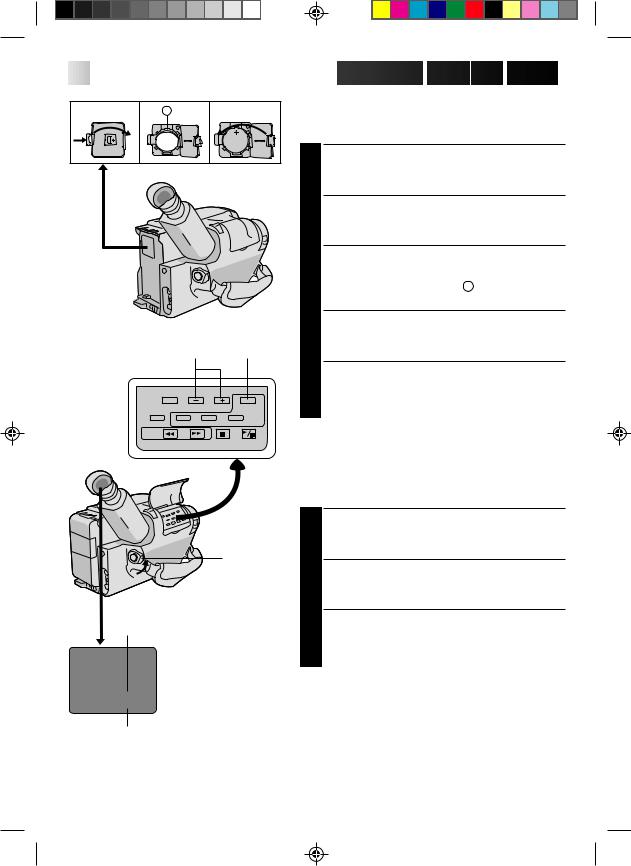
10











































 GETTING
GETTING STARTED
STARTED (cont.)
(cont.)
A
–/+ SET
POWER
Date
Month/Day/Year
DATE ... Date setting is performed
Clock (Lithium) Battery Removal/Insertion
This battery is necessary to operate the clock and to perform date/time settings.
SWITCH OFF POWER
1 Switch off the unit’s power and remove the power supply unit.
OPEN COVER
2 Open the clock battery compartment cover while pressing the release tab.
REMOVE BATTERY (when replacing)
3 Insert a pointed, non-metallic object between the
battery and the compartment ( A ) and pull the battery out.
INSERT BATTERY
4 Ensuring the plus (+) side is up, insert the supplied lithium battery and push it in.
CLOSE COVER
5 Close the compartment cover until it clicks in place.
NOTE:
See “SAFETY PRECAUTIONS”(Z pg. 2) for information on safe handling of lithium batteries.
Date/Time Settings
SELECT MODE
1 Set the power switch to CAMERA.
SET DATE/TIME
2 Press SET and the month blinks. Press + or – to set the month. Repeat to set day, year, hour and minute.
START CLOCK
3 Press SET. The blinking stops. The date and time are both displayed for confirmation, then the time display disappears.
DATE JAN 1.00
TIME AM12:00
Time
12-hour indication with AM or PM TIME .... Time setting is performed
NOTE:
The clock does not keep time while the date and time are blinking.
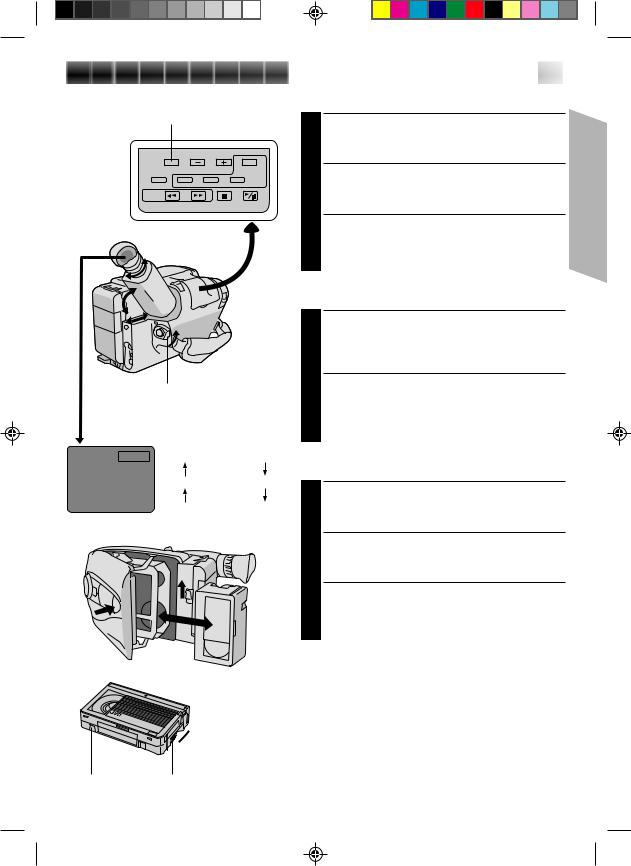
SP-EP recording mode and T20•30•40 tape length select button
Set POWER to “CAMERA”.
Tape length and recording mode indicator
T30 SP  T20 SP
T20 SP  T20 EP
T20 EP
T40 EP |
T30 SP |
T40 SP T30 EP
T30 EP
Turn to take up
 slack.
slack.
Erase Protection Gear




 11
11
Viewfinder Adjustment
POSITION VIEWFINDER
1 Adjust the viewfinder manually for best viewability (see illustration at left).
SELECT MODE
2 Set the power switch to CAMERA.
ADJUST DIOPTER
3 Turn the diopter adjustment control until the indications in the viewfinder are clearly focused.
Tape Length/Recording Mode Setting
SET TAPE LENGTH
1 Set the tape length button according to the length of the tape used. T20 = 20 minutes of recording time, T30 = 30 minutes, and T40 = 40 minutes (in SP).
SET RECORDING MODE
2 Set depending on your preference. “SP” (Standard Play) provides higher picture and sound quality and is better for dubbing, while “EP” (Extended Play) is more economical, recording at 1/3 the speed of SP.
Loading/Unloading A Cassette
OPEN CASSETTE HOLDER
1 Slide EJECT until holder opens. Do not use force to open.
INSERT/REMOVE CASSETTE
2 Make sure label is facing outward.
CLOSE CASSETTE HOLDER
3 Press PUSH and make sure the holder is closed and locked.
NOTES:
cA cassette holder can’t be opened unless a power supply is attached.
cMake sure that the tape is not slack when loading the cassette. If there is any slack, turn the gear on the cassette in the direction of the arrow to take up the slack.
cMake sure the Erase Protection tab is present. If not, cover the hole with adhesive tape. (Some cassettes have sliding tabs – in this case, check the tab’s position.)
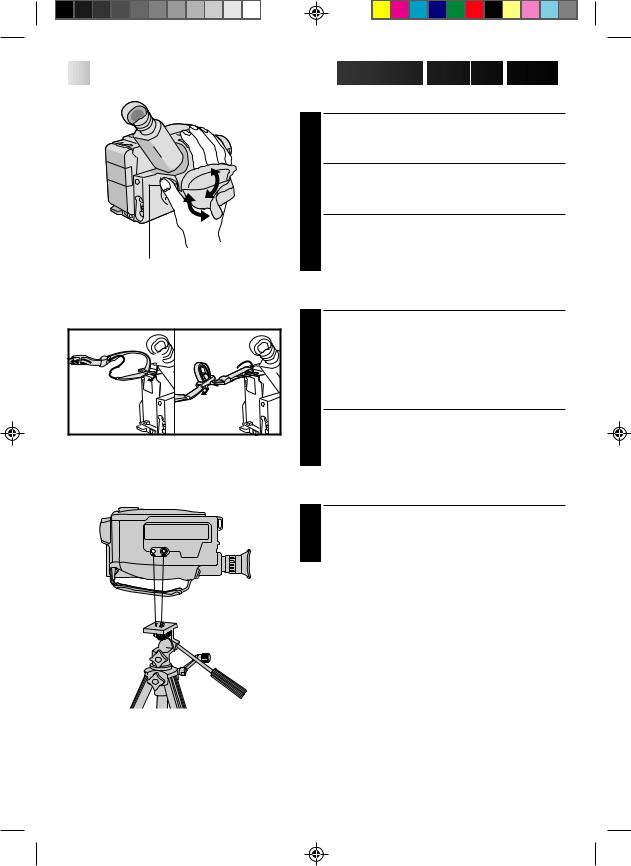
12











































 GETTING
GETTING STARTED
STARTED (cont.)
(cont.)
Grip Adjustment
EXPAND LOOP
1 Separate the Velcro strip.
|
INSERT HAND |
|
Pass your right hand through the loop and grasp the |
|
2 grip. |
|
ADJUST STRAP LENGTH |
|
Adjust so your thumb and fingers can easily operate |
Recording Start/Stop button |
3 the Recording Start/Stop button and Power Zoom |
switch. Refasten the Velcro strip. |
|
|
Shoulder Strap Attachment |
|
|
ATTACH STRAP |
|
|
Following the illustration at left, thread the strap |
|
1 |
1 through the top of the eyelet 1, then fold it back |
|
and thread it through the keeper 2, and then |
|
3 |
|
through the buckle 3. Repeat the procedure to |
2 |
2 |
attach the other end of the strap to the other eyelet, |
|
making sure the strap isn’t twisted. |
|
|
1 |
ADJUST LENGTH |
|
|
|
|
|
Adjust as shown in the illustration at left 1, then |
|
|
2 slide both keepers snug against the eyelets to |
|
|
prevent slipping 2. |
Tripod Mounting
ALIGN AND TIGHTEN
1 Align the screw and camera direction stud on the tripod with the camera’s mounting socket and stud hole. Then tighten the screw.
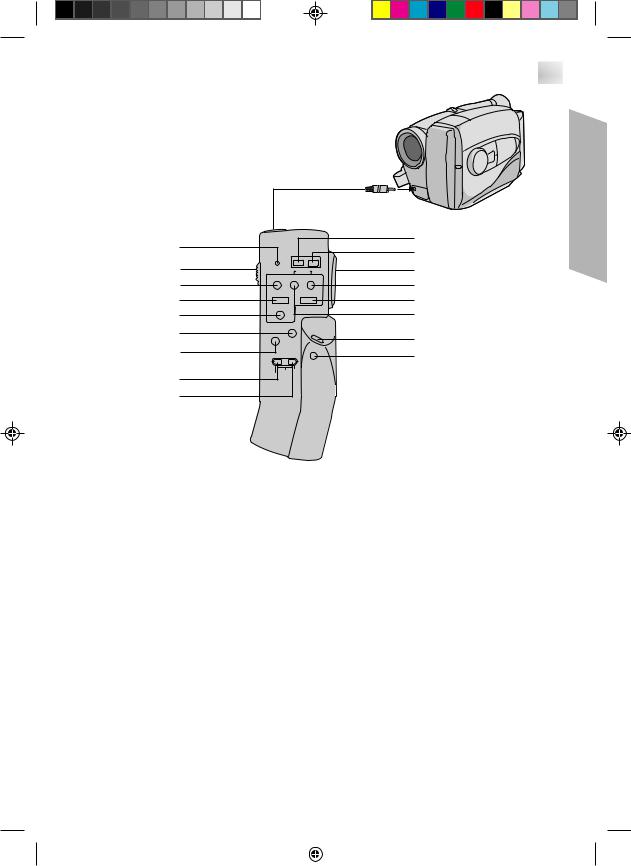









 13
13
RM-V20U Remote Control Unit
The RM-V20U (optional) permits VCR functions to be controlled from a distance. When using the RM-V20U, connect its cable to the camcorder’s REMOTE jack.
* Before use, refer to the RM-V20U instruction booklet.
|
To REMOTE |
|
1 |
0 |
|
! |
||
2 |
||
@ |
||
3 |
# |
|
4 |
$ |
|
5 |
% |
|
6 |
^ |
|
7 |
||
& |
||
8 |
|
|
9 |
|
Buttons |
|
|
|
Functions |
||
|
|
|
|
|
||
With the camcorder’s power switch |
With the camcorder’s power switch set |
|||||
|
||||||
|
set to “CAMERA”. |
to “PLAY”. |
||||
|
|
|
|
|
|
|
1LED indicator |
Lights when a signal is transmitted. |
|
||||
2KEY-LOCK switch |
Switching to “;” turns off the remote control unit’s power. Decreases battery power |
|||||
consumption, and prevents accidental operation by young children, etc. |
||||||
|
||||||
3REC |
— |
— |
||||
4STOP |
— |
Stop (Z P. 30) |
||||
5PAUSE/MONITOR |
— |
Pause (Z P. 31) |
||||
6AUDIO DUB |
— |
Audio Dubbing (Z P. 37) |
||||
7INSERT |
— |
Insert Editing (Z P. 36) |
||||
8REC TIME |
Animation/Time-Lapse (Z P. 27) |
— |
||||
9INTERVAL |
Self-Timer (Z P. 26)/Time-Lapse (Z P. 27) |
— |
||||
0POWER OFF |
Power off |
|
||||
!POWER ON |
Power on |
|
||||
@ZOOM (T/W) |
Slow-speed zoom (Z P. 15) |
— |
||||
#FF/RETAKE |
Retake (Forward) (Z P. 15) |
FF/FF Shuttle Search (Z P. 30) |
||||
$PLAY |
— |
Playback start (Z P. 30) |
||||
%REW/RETAKE |
Retake (Rewind) (Z P. 15) |
Rew/Rew Shuttle Search (Z P. 30) |
||||
^START/STOP |
Functions same as the Recording/Stop button of a camcorder. |
|||||
&VISS |
Index Code Marking (Z P. 15) |
— |
||||
|
|
|
|
|
|
|
|
|
|
|
|
|
|
|
|
|
|
|
|
|
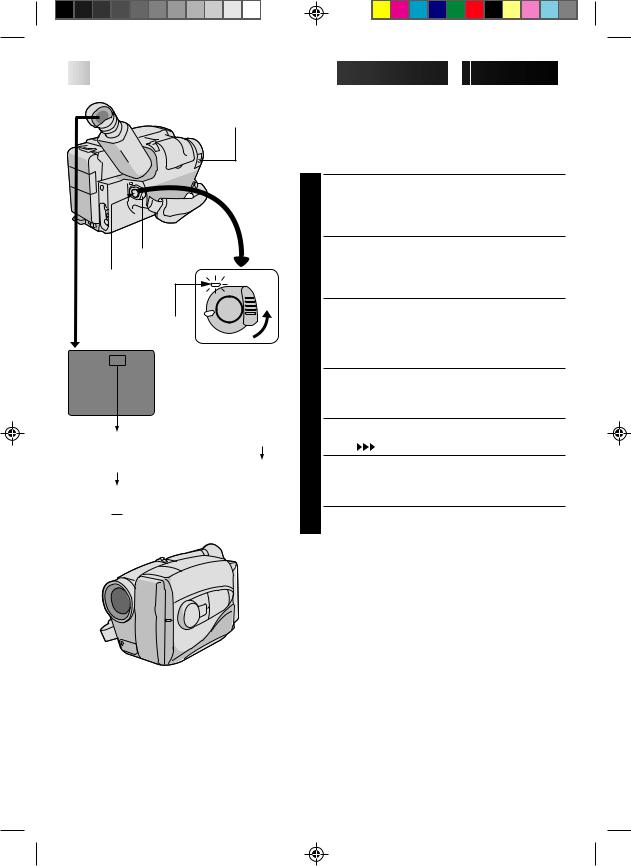
14











































 RECORDING
RECORDING
 Basic Recording
Basic Recording
LENS COVER
SWITCH
POWER
Start/Stop
The power indicator
Tape remaining time indicator
120MIN 119MIN
119MIN 3MIN
3MIN
1MIN (Blinking) 2MIN (Blinking)
2MIN (Blinking)
0MIN (Blinking)
*MIN.....(Now calculating)
NOTE:
You should already have performed the procedures listed below. If not, do so before continuing.
cPower (Z pg. 8)
cTape Length/Recording Mode Setting (Z pg. 11)
cGrip Adjustment (Z pg. 12)
LOAD A CASSETTE
1 Slide EJECT to open the cassette holder, then insert the cassette with the label facing out. Press PUSH to ensure the holder is closed and locked.
ENTER RECORD–STANDBY MODE
2 Slide the LENS COVER open/close switch to open the lens cover, then set the power switch to CAMERA.
•The power indicator lights and the camcorder enters the Record–Standby Mode.
•The scene you’re aimed at appears on the viewfinder screen, with the word “PAUSE” superimposed upon it.
START SHOOTING
3 Press the Recording Start/Stop button.
•The tally lamp lights while recording is in progress, and “REC ” appears in the viewfinder.
STOP RECORDING
4 Press the Recording Start/Stop button again.
•The camcorder re-enters the Record-Standby mode.
NOTES:
|
|
c A cassette holder can’t be opened unless a power |
|
|
|
supply is attached. |
|
|
|
c There may be a delay after you slide EJECT until the |
|
|
|
holder opens. Do not use force. |
|
|
|
c The tape’s remaining time is displayed in the |
|
|
|
viewfinder as shown. |
|
|
|
c “TAPE END” appears when the tape reaches its end, |
|
|
|
and the power goes off automatically if left in this |
|
|
|
condition for 5 minutes. “TAPE END” also appears |
|
|
|
when a cassette whose tape is already at its end is |
|
|
|
loaded. |
|
|
|
c If the Record–Standby mode continues for 5 minutes, |
|
Tally lamp |
the camcorder’s power shuts off automatically. Set the |
||
power switch to POWER OFF, and then back to |
|||
|
|
||
|
|
CAMERA to turn the camcorder on again. |
|
cIf you’re recording on a cassette from the middle, use the RETAKE function (Z pg. 15) to find the end of the last recording so you don’t erase any of it.
cThe LENS COVER warning blinks for about 5 seconds when the camcorder is turned on, whether the cover is open or closed.
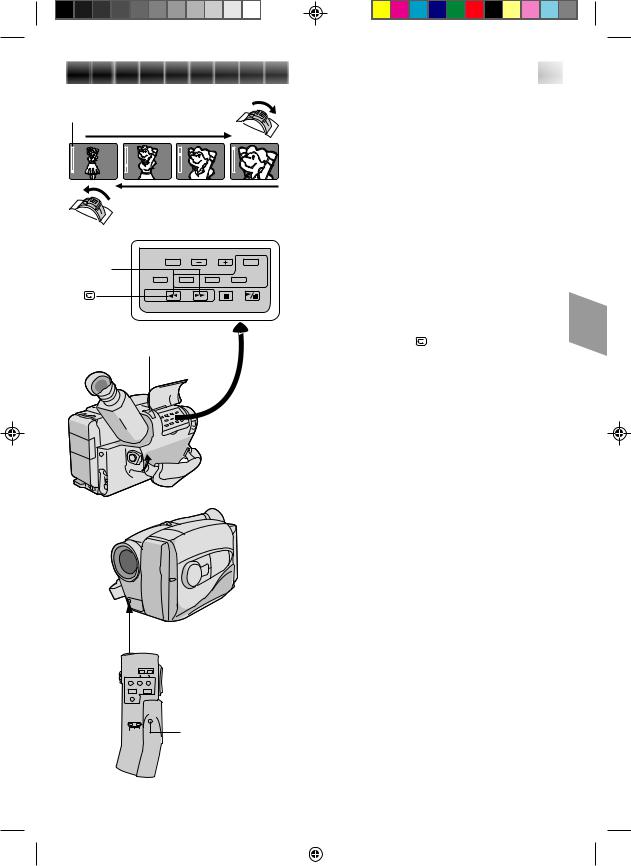
RECORDING Basic Features
Zoom indicator
Zoom-in
T |
T |
T |
T |
W |
W |
W |
W |
|
|
Zoom-out |
|
RETAKE
Power zoom switch


 START/STOP
START/STOP
VISS
RM-V20U (optional)




 15
15
|
FEATURE: |
Zooming |
||
|
PURPOSE: |
To vary the length of the focal lens and |
||
|
|
|
|
produce zoom in/out effect. |
|
OPERATION: |
Zoom In |
||
|
|
|
|
1) Pull the power zoom switch down |
|
|
|
|
toward “T”. |
|
|
|
|
Zoom Out |
|
|
|
|
2) Push the switch up toward “W”. |
|
NOTES: |
c The further the power zoom switch is |
||
|
|
|
|
pushed or pulled, the faster the zoom |
|
|
|
|
speed becomes. |
|
|
|
|
c Focusing may become unstable during |
|
|
|
|
zooming. In this case, set zoom while in |
|
|
|
|
Record–Standby, set manual focus or |
|
|
|
|
Focus Lock (Z pg. 20), then zoom in or |
|
|
|
|
out in RECORD mode. |
|
|
|
|
|
|
FEATURE: |
Quick Review |
||
|
PURPOSE: |
To check end of last recording for |
||
|
|
|
|
confirmation. |
|
OPERATION: |
1) Press “ ” for less than 2 seconds during |
||
|
|
|
|
Record–Standby mode. |
|
|
|
|
• Tape is rewound for about 2 seconds |
|
|
|
|
and played back automatically, then |
|
|
|
|
pauses in Record–Standby mode for |
|
|
|
|
next shot. |
|
NOTE: |
Distortion may occur at start of playback. |
||
|
|
|
|
This is normal. |
|
|
|
|
|
|
FEATURE: |
Retake |
||
|
PURPOSE: |
To re-record certain segments. |
||
|
OPERATION: |
1) Make sure camcorder is in |
||
|
|
|
|
Record–Standby mode. |
|
|
|
|
2) Press either RETAKE button to reach start |
|
|
|
|
point for new recording. |
|
|
|
|
3) Press Recording Start/Stop to start |
|
|
|
|
recording. |
|
NOTE: |
Noise may appear during Retake. |
||
|
|
|
|
This is normal. |
|
|
|
|
|
|
FEATURE: |
Index Code Marking |
||
|
PURPOSE: |
To give you automatic access to any selected |
||
|
|
|
|
point on a recording. Auto Marking and |
|
|
|
|
Manual Marking are available. |
|
OPERATION: |
Auto Marking |
||
|
|
|
|
An index code is always marked to start the |
|
|
|
|
first recording on a new date after a cassette |
|
|
|
|
is inserted. |
|
|
|
|
Manual Marking |
|
|
|
|
1) Press VISS once to place index code. |
|
|
|
|
INDEX blinks in the viewfinder during |
|
|
|
|
marking. |
|
NOTES: |
c If VISS is pressed during |
||
|
|
|
|
Record–Standby mode, the mark is |
|
|
|
|
placed where START/STOP is pressed. |
|
|
|
|
c If the date changes during a recording, it |
|
|
|
|
becomes the first recording of the new |
|
|
|
|
date and an index mark is placed at that |
|
|
|
|
point. |
|
|
|
|
|
|
|
|
|
|
|
|
|
|
|
|
|
|
|
|
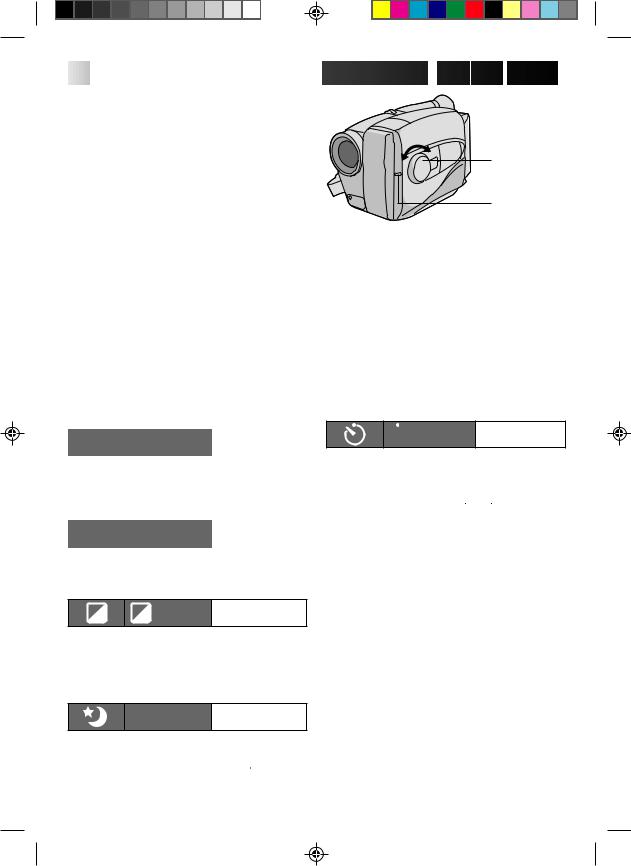
16









































 RECORDING
RECORDING Advanced
Advanced Features
Features
Program AE With Special Effects
All you have to do to access any of the variety of shooting effects is to turn the PROGRAM AE select dial until the desired indication appears in the viewfinder. The mode is activated about 1 second later.
DIAL |
VIEWFINDER |
MODE |
|
SYMBOL |
|||
|
|
||
|
|
|
|
LOCK |
A AUTO LOCK |
Auto Mode Lock |
Auto Mode Lock
Locks camcorder in Full Auto mode, preventing accidental misoperation/button pressing during shooting.
•CINEMA, FADER, FOCUS, EXPOSURE, DISPLAY, TITLES and MWB (Manual White Balance) controls are disabled in this mode.
RELEASE |
M AUTO RELEASE |
Auto Mode |
Release |
Auto Mode Release
Re-enables controls that were disabled by Auto Mode Lock.
FG |
FG:FOG |
Electronic Fog Filter |
|
|
|
Electronic Fog Filter
Makes picture look misty white, as when external fog filter is attached to lens. Softens image and gives it “fancy” look.
ND |
ND:ND EFFECT |
ND Effect |
|
|
|
ND EFFECT
Black mist darkens picture, as when ND filter is used. Helps to counter effects of glare on subject.
PROGRAM AE select dial
Tally lamp
DIAL |
VIEWFINDER |
MODE |
|
SYMBOL |
|||
|
|
||
|
|
|
|
|
SPORTS |
Sports |
|
|
|
|
Sports
High shutter speed clearly captures fast-moving action.
1/2000 |
S 1/2000 |
High Speed Shutter |
|
|
|
High-Speed Shutter (1/2000s.)
Captures faster action than Sports mode.
 SELF TIMER 15 sec. Self-Timer
SELF TIMER 15 sec. Self-Timer
15sec. Self-Timer
Lets you delay recording start after Recording Start/ Stop is pressed. If camcorder is secured, operator can enter scene before recording starts.
1)Set PROGRAM AE dial to “ ”. “
”. “ 15S” appears in viewfinder.
15S” appears in viewfinder.
2)Press Recording Start/Stop.
•Recording starts after 15 seconds.
•Tally lamp begins blinking; blinking speed increases about 5 seconds before recording starts. Blinking stops when recording begins but light stays on.
SEPIA Sepia
Sepia
Scene being shot is recorded in sepia-tinted (reddish-brown) monochrome, giving effect of older movie. Use together with Cinema (Z pg. 19) for authentic look of classic Hollywood movie.
 TWILIGHT Twilight
TWILIGHT Twilight
Twilight
Disengages auto gain control and auto focus, locks focus to infinity and white balance to “


 ” (outdoor) mode. Dusk, twilight scenery, fireworks, etc., look more natural and dramatic.
” (outdoor) mode. Dusk, twilight scenery, fireworks, etc., look more natural and dramatic.
NOTES:
cOnly one effect can be engaged at a time.
cWhen the PROGRAM AE select dial is switched from one mode to another, the newly selected mode’s name and its indication is displayed in the viewfinder for approx. 3 seconds. Then the name disappears, and only the indication remains.
cThe screen becomes slightly reddish when the fader (Z pg. 18) is used in the Sepia mode.
cThe screen becomes slightly dark in the High Speed Shutter mode. Use in well-lighted situations.
cIn the High Speed Shutter or Sports modes, picture color may be adversely affected if subject is lit by alternating discharge-type light sources such as flourescent or mercury-vapor lights.
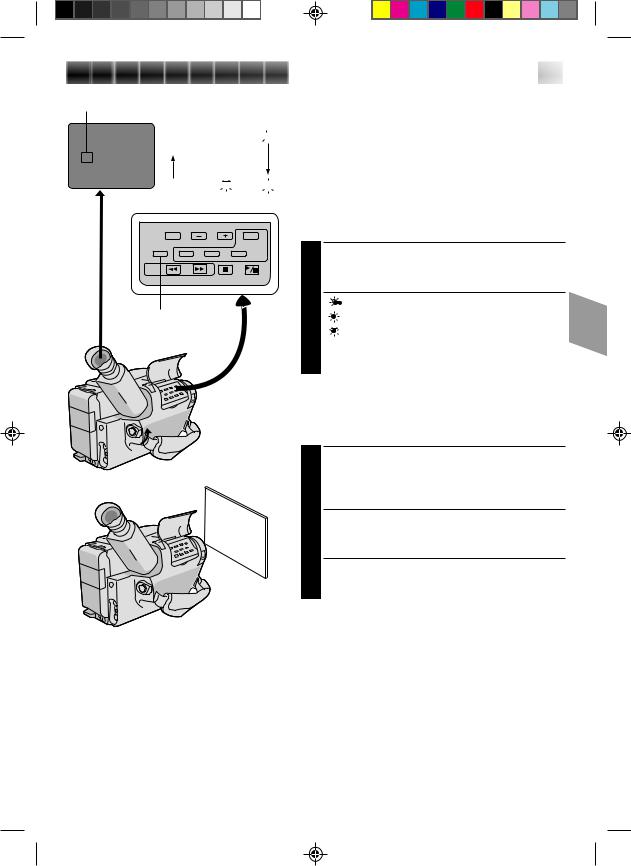
White balance mode indicator
No indication 

 (Auto)
(Auto)
MWB 






MWB
NOTES:




 17
17
White Balance Adjustment
This camcorder’s Automatic Color Temperature system senses the color temperature of the ambient lighting for automatic white balance adjustment. However, precise color adjustment is not possible under the following conditions:
•When an object is in various shades of the same color. •When a predominantly red or brown object is being
shot outdoors.
In these cases, use the camcorder’s built-in preset filters for white balance adjustment.
SELECT MODE
1 Press MWB (Manual White Balance) until the required indication appears in the viewfinder.
“ ” .............. |
Outdoors on cloudy day |
“ ” ............... |
Outdoors on sunny day |
“ ” ................ |
Light source is halogen or tungsten |
|
lamp |
“MWB” .......... |
With a memorized personal White |
|
Balance setting (see below) |
MWB sets the color temperature for the subject’s light source so you can shoot with natural colors that are unaffected by surroundings, even when there are multiple subjects with different color temperatures.
ADJUST FOCUS
1 Point the camcorder at a white, flat object such as a sheet of white paper, and adjust focus manually (Z pg. 21).
ADJUST WHITE BALANCE
2 Press MWB until ”MWB“ appears, then press and hold MWB for more than 3 seconds.
•”MWB” blinks in the viewfinder during adjustment, then stops blinking but stays lit when adjustment is complete.
cTo switch to automatic white balance adjustment, press MWB until the indication disappears, or turn the PROGRAM AE dial to LOCK.
cRe-adjust the White Balance mode when the lighting has changed, when the camcorder has been turned on and off again, or when the PROGRAM AE dial’s position has been changed.
cIt is helpful to connect your camcorder to a color monitor when adjusting the white balance (“BASIC CONNECTIONS” Z pg. 29).
cWhen adjusted by putting colored paper in front of the subject in step 2 , this unit makes its color temperature standard for automatic white balance. So you can enjoy shooting with different colors. For example, when adjusting with red, blue or yellow colors, the image becomes the color which aproximates to green, orange or purple respectively.
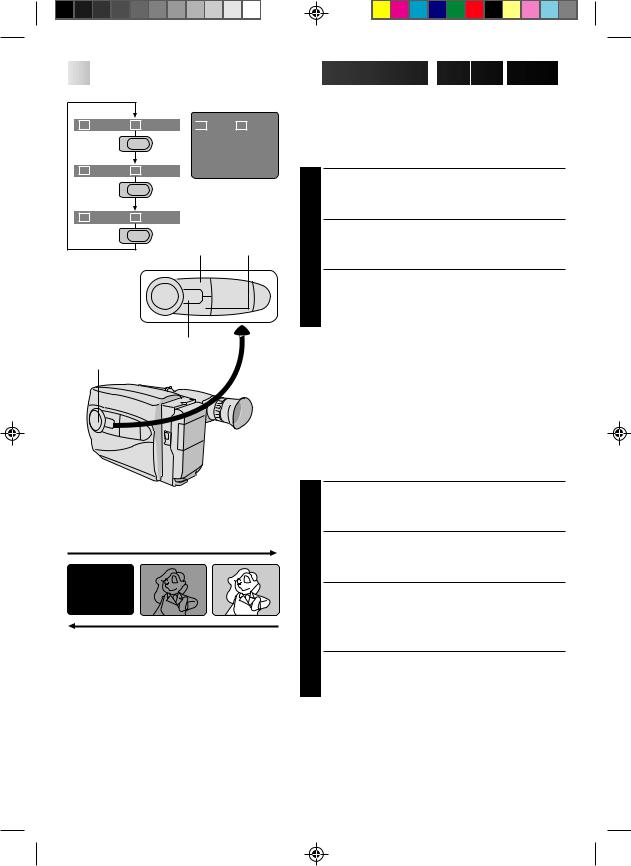
18



































Group 1
F1 FADER F2 CINEMA  F1 FADER F2 CINEMA
F1 FADER F2 CINEMA
SEL.
Group 2
F1 FOCUS F2 EXP.
SEL. Viewfinder
Group 3






 RECORDING
RECORDING Advanced
Advanced Features
Features
INTELLIGENT FUNCTION CONTROL
This feature makes it easier for you to make selections during the following modes: Fader, Cinema, Manual Focus Adjust, Exposure Control, Display, and Instant Title.
PREPARATION
1 Set the PROGRAM AE dial to any position except LOCK.
F1 TITLE |
F2 DISP. |
SEL.
F1 button F2 button
F1
SEL
F2
Function SEL. button
PROGRAM AE select dial
SELECT MODE
2 Press Function SEL. until the required function’s indication appears in the viewfinder.
ENTER SELECTION
3 Press either F1 or F2 (the one to the immediate left of the desired function name).
NOTE:
If you set the PROGRAM AE dial to LOCK, F1 and F2 disappear from the viewfinder, indicating that IFC (Intelligent Function Control) is unusable.
FADE IN
FADE OUT
Fader
This feature allows smooth fade-in and fade-out to black blank screen. Fade-in works at recording start, and fade-out works at recording end or when you enter Record–Standby mode.
SELECT MODE
1 Press Function SEL. until “FADER” appears to the right of F1.
ENGAGE FADE–STANDBY MODE
2 Press F1 to engage the Fade–Standby mode. “FADER”appears in the viewfinder.
START RECORDING
3 Press Recording Start/Stop to start recording and activate fade-in.
OR . . .
END RECORDING
Press Recording Start/Stop to end recording and engage fade-out.
NOTES:
cPressing and holding the Recording Start/Stop button allows you to record a black blank screen.
cThe screen becomes slightly reddish when the Fader is used with Sepia (Z pg. 16).
cWith the Electronic fog filter mode (Z pg. 16) engaged, the image fades in/out to a white screen.
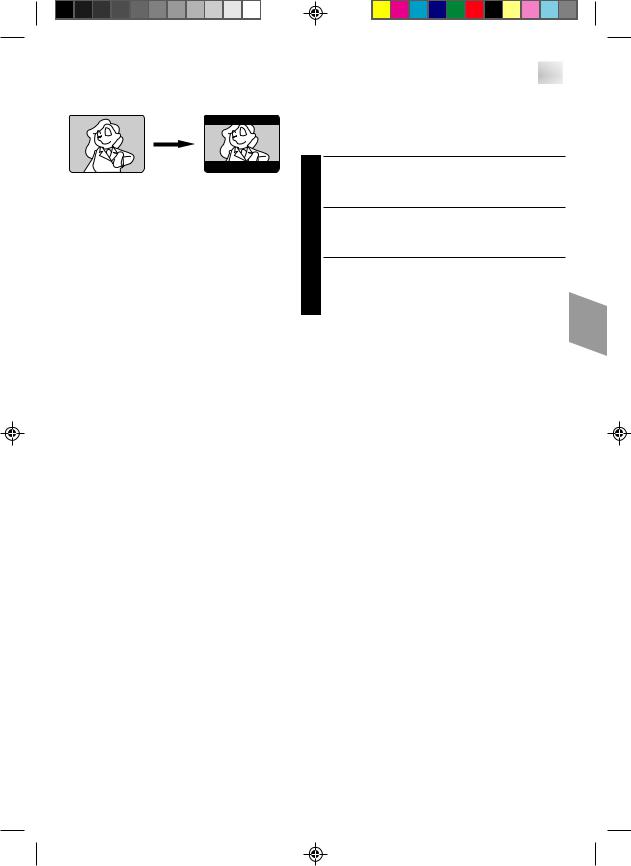









 19
19
Cinema mode Cinema
This feature allows you to record black bars at the top
and bottom of the screen to produce a cinema-like “wide-screen” effect.
SELECT MODE
1 Press Function SEL. until “CINEMA” appears to the right of F2.
ENGAGE CINEMA MODE
2 Press F2.
RESTORE NORMAL SCREEN
3 Press F2 again while “CINEMA” appears next to F2 in the viewfinder.
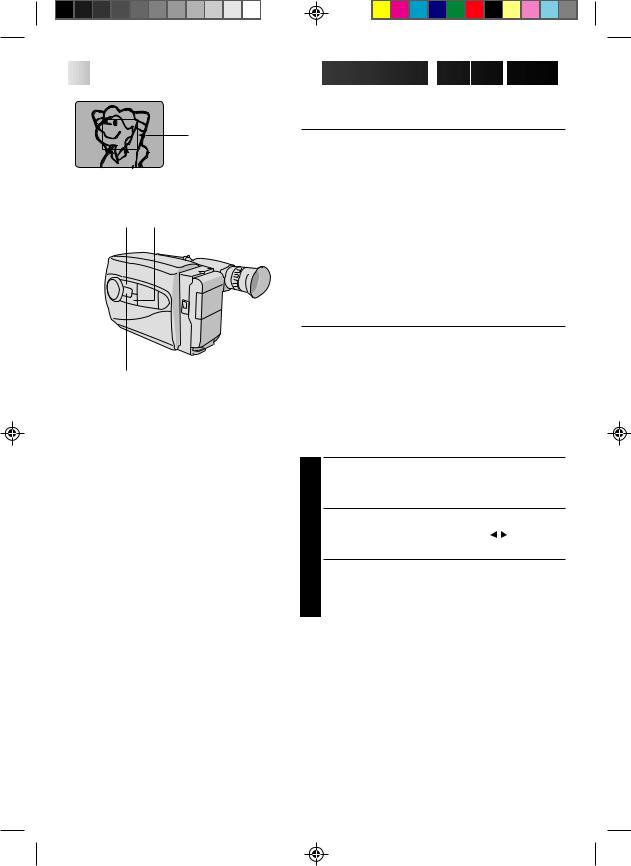
20









































 RECORDING
RECORDING Advanced
Advanced Features
Features
Focusing
Focus
detection zone
F1 F2
Function SEL.
Auto Focus
The camcorder’s Full Range AF system offers continuous shooting ability from close-up to infinity. However, correct focus may not be obtainable in the situations listed below (in these cases use manual focusing):
•When two subjects overlap in the same scene. •When illumination is low.*
•When the subject has no contrast (difference in brightness and darkness), such as a flat, one-color wall, or a clear, blue sky.*
•When a dark object is barely visible in the viewfinder.* •When the scene contains minute patterns or identical
patterns that are regularly repeated.
*The low-contrast warning “

 ” appears in the viewfinder.
” appears in the viewfinder.
Focus Lock
This feature locks the focus in place, which is especially helpful in the following situations:
•When things pass between your subject and the camcorder. Engage the focus lock function to lock your subject in before recording.
•When you want your subject to be focused, and to appear in a corner of the screen. First, center on the subject and focus using auto focus mode. Then engage the focus lock function and move the camcorder until the subject is where you want it.
1
2
3
SELECT MODE
Press Function SEL. until “FOCUS” appears to the right of F1.
LOCK FOCUS
Press F1. The focus lock indication “ |
” appears |
in the viewfinder. |
|
RELEASE FOCUS LOCK
Press F1. Focus lock is immediately released. The focus lock indication disappears.
NOTES:
cIf the lens is smeared or blurred, accurate focusing is not possible. Keep the lens clean, wiping with a piece of soft cloth if it gets dirty. When condensation occurs, wipe with a soft cloth or wait for it to dry naturally.
cWhen shooting a subject close to the lens, zoom-out first (Z pg. 15). If zoomed-in in the auto focus mode, the camcorder could automatically zoom out depending on the distance between the camcorder and the subject.
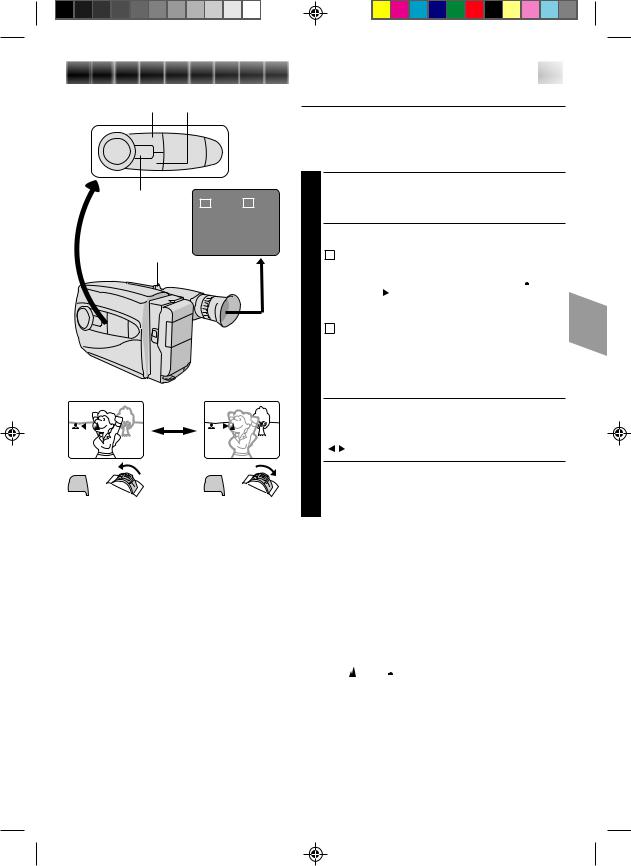
F1 button |
F2 button |
|
|
F1 |
|
|
|
SEL |
|
|
|
F2 |
|
|
|
Function SEL. |
F1 FOCUS F2 |
EXP. |
|
button |
|||
|
|
Power zoom switch
Viewfinder
F1 + |
F1 + |




 21
21
Manual Focus
NOTE:
You should already have made the necessary viewfinder adjustments (Z pg. 11). If you haven’t, do so before continuing.
SELECT MODE
1 Press Function SEL. until “FOCUS” appears to the right of F1.
ADJUST FOCUS
A TO FARTHER SUBJECT
2
2 While holding down F1, slide the power zoom switch to T. The Manual Focus indications “
 ” appear and “ ” blinks.
” appear and “ ” blinks.
Go to step 3.
B TO NEARER SUBJECT
While holding down F1, slide the power zoom switch to W. The Manual Focus indications
“

 ” appear and “
” appear and “ ” blinks. Go to step 3.
” blinks. Go to step 3.
LOCK FOCUS
3 Release the power zoom switch. The focus indication is replaced by the focus lock indication
“” and the adjusted focus is locked in.
RELEASE MANUAL FOCUS MODE
4 Press F1. The Manual Focus mode is immediately released and the focus lock indication disappears.
NOTES:
cBe sure to focus the lens in the maximum telephoto position when you use the Manual Focus mode. If you focus in on a certain subject in the wide-angle position, sharply focused images cannot be obtained when zoomed up because the depth-of-field is reduced at longer focal lengths.
cTwo manual focusing speeds are available. For slow-speed, push the switch slightly and hold that position. For fast-speed, push the switch fully.
cWhen the focus level cannot be adjusted any farther or closer, “ ” or “ ” will blink.
” will blink.
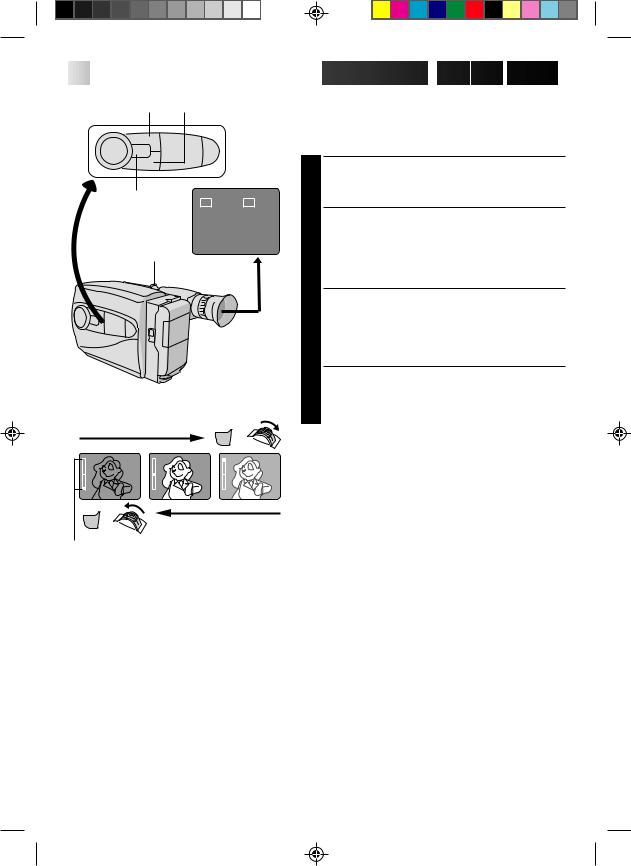
22









































 RECORDING
RECORDING Advanced
Advanced Features
Features
|
F1 button F2 button |
Exposure Control |
|
|
|
|
This feature automatically adjusts the iris for the best |
|
F1 |
|
available picture quality, but you can override and make |
|
|
the adjustment manually. |
|
|
SEL |
|
|
|
|
SELECT MODE |
|
|
F2 |
|
|
|
|
|
Press Function SEL. until “EXP.” appears to the right |
|
Function SEL. |
F1 FOCUS F2 EXP. |
1 of F2. |
|
button |
|
BRIGHTEN IMAGE |
|
|
|
|
|
|
|
While holding down F2, slide the power zoom |
Power zoom switch |
|
2 switch to T. The Exposure indicator bar appears in |
|
Viewfinder |
the viewfinder. |
||
|
|
OR . . . |
|
|
|
|
|
|
|
|
DARKEN IMAGE |
|
|
|
While holding down F2, slide the power zoom |
|
|
|
switch to W. The Exposure indicator bar appears in |
|
|
|
the viewfinder. |
|
|
|
When you want to return to the factory setting . . . |
|
|
|
RESTORE INITIAL SETTING |
|
|
|
Press F2. The standard setting is immediately |
|
|
|
3 restored and the Exposure indicator bar disappears. |
To brighten the image |
|
||
|
|
F2 + |
|
+ |
+ |
+ |
|
- |
- |
- |
|
F2 |
+ |
To darken the image |
|
Exposure indicator bar
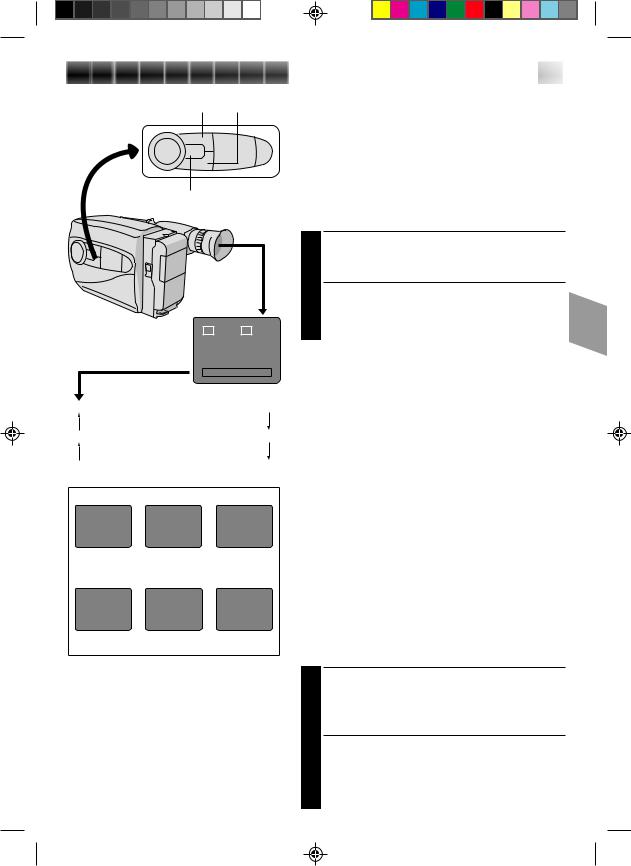
F1 button |
F2 button |
F1
SEL
F2
Function SEL. button
F1 TITLE F2 DISP.
Date display  Auto Date Record mode
Auto Date Record mode
Character Generator |
Date/Time display |
Date-off mode On-screen display
On-screen display
Date display |
Auto Date Record mode |
|
DEC 25.96 |
AUTO DATE |
DEC 25.96 |
|
Auto date |
Auto date |
|
record mode |
record executed |
Date/Time display |
Character Generator |
|
DEC 25.96 PM 10:50 |
SET CHAR |
IN PARIS, FRANCE |
|
No Characters |
Example of |
|
stored |
stored characters |
|
|
|
NOTES:
cIn the On-Screen Display mode, the date is displayed and recorded.
cThe on-screen display is not available during recording.




 23
23
Date/Time Character Insert
This feature allows you to display date, time and characters in your viewfinder and on a connected color monitor, record them manually or automatically, and even make your own titles.
NOTE:
You should already have performed the Date/Time Setting procedure (Z pg. 10). If you haven’t, do so before continuing.
DISPLAY
SELECT DISPLAY
1 Press Function SEL. until “DISP.” appears to the right of F2.
CHOOSE DISPLAY MODE
2 Press F2 while in Record–Standby to cycle through the modes as shown in the illustration at left.
NOTES:
cThe selected display can be recorded.
cIf you don’t want to record the display, select Date-off mode before shooting.
cIf you want to delete the display during shooting, press F2.
cIf you want to call back a deleted display, engage the Record– Standby mode and then select the desired display mode using F2.
AUTO DATE RECORD
Your camcorder automatically records the month, day and year for about 5 seconds after recording is initiated in the following situations:
•After changing the date. •After loading a cassette.
•After Auto Date Record mode is selected by pressing F2. In this mode, the month, day and year are replaced after 5 seconds with “AUTO DATE”.
NOTES:
cSetting PROGRAM AE to LOCK always engages this mode, and disables all other modes.
cIn the Auto Date Record mode, if the date changes while you’re shooting, the date indication is recorded for about 5 seconds from that point. It is not recorded during any other recordings made on that day.
ON-SCREEN DISPLAY
CONNECT CAMCORDER TO MONITOR
1 Connect the camcorder to a monitor as instructed in “BASIC CONNECTIONS” (Z pg. 29).
DISPLAY VIEWFINDER INDICATIONS
2 Press F2 until the indications appear on the connected monitor.
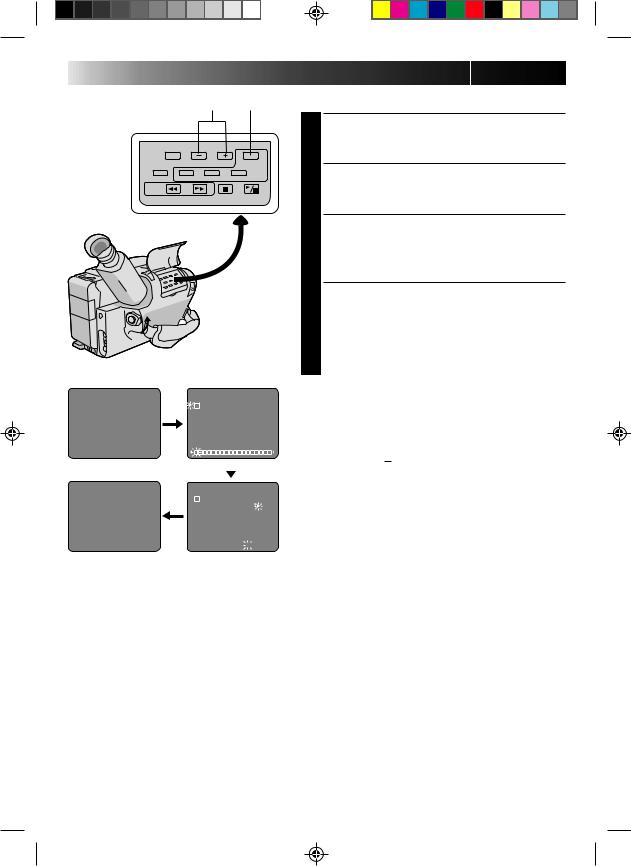
–/+ SET |
Character Generator |
24 |
SELECT MODE |
Press Function SEL. until “DISP.” appears to the right |
|
1 of F2. |
|
SET CHARACTER OR TITLE |
|
Press F2 until “SET CHAR” or a previously stored |
|
2 title appears in the viewfinder. |
|
ACCESS CHARACTER MODE |
|
SCREEN |
|
Press SET. A character grid appears in the view |
|
3 finder. |
|
ENTER DESIRED CHARACTERS |
|
Press + or – to move the cursor on the character grid |
|
4 to the desired character, then press SET to enter. The |
|
selected characters appears at the bottom of the |
|
screen. When you’re done, press SET as many times |
|
as necessary to exit the screen. The title you made |
|
appears at the bottom of the screen. |
|
RECORDING Advanced Features |
|
CHARACTER |
|
SET MODE screen |
|
SET CHAR
IN PARIS, FRANCE
CHARACTER SET MODE
|
A B C D E F G H |
I |
||||||
J K L M N O P Q R S |
||||||||
T U V W X Y Z Ä Ö Ü |
|
|||||||
À È |
Ì |
Ò Ù Ñ Æ Ø Å & |
|
|||||
: |
|
. , |
' |
- |
/ |
! |
? ¿k |
|
0 1 2 |
3 4 |
5 6 |
7 8 |
9 |
||||
|
||||||||
|
|
|||||||
CHARACTER SET MODE |
||||||||
|
A B C D E F G H |
I |
||||||
J K L M N O P Q R S |
||||||||
T U V W X Y Z Ä Ö Ü |
|
|||||||
À È |
Ì |
Ò Ù Ñ Æ Ø Å & |
|
|||||
: |
|
. , |
' |
- |
/ |
! |
? ¿k |
|
0 |
1 2 |
3 4 |
5 |
6 |
7 |
8 |
9 |
|

 I N
I N  PAR I S,
PAR I S,  FR
FR






NOTES:
cYou can store up to 18 characters.
cYou can only make and store one title at a time. To replace it, repeat the procedure.
cTo create a space between two characters in a title you
make, choose “  ” on the CHARACTER SET MODE screen.
” on the CHARACTER SET MODE screen.
CHARACTER
SET MODE screen
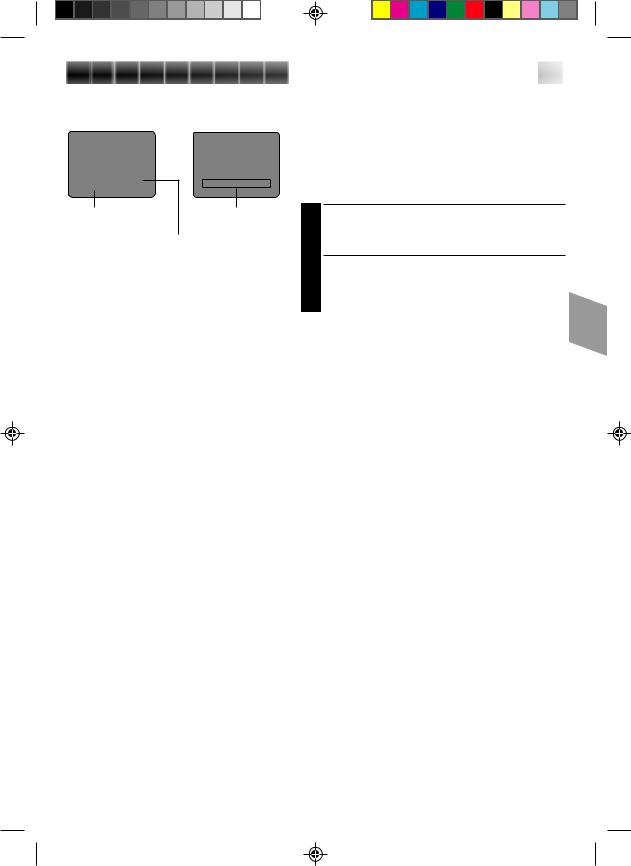
Example of Character Generator & Title
Viewfinder
OUR VACATION
IN PARIS, FRANCE
Character Generator: |
Title indication |
IN PARIS, FRANCE
Title: OUR VACATION




 25
25
Instant Titles
The camcorder has eight preset titles in memory. You can superimpose one of them above a previously stored title as shown in the illustration to the left.
The preset titles appear in this order: HAPPY BIRTHDAY, OUR VACATION, MERRY CHRISTMAS, A SPECIAL DAY, HAPPY HOLIDAYS, OUR NEW BABY, WEDDING DAY, CONGRATULATIONS.
SELECT MODE
1 Press Function SEL. until “TITLE” appears to the right of F1.
SELECT PRESET TITLE
2 Engage the Record–Standby mode, then press F1 to cycle through the preset titles until the desired title is displayed.
NOTES:
cTo delete the Instant Title during recording, press F1.
cTo recall a title, engage the Record–Standby mode and then press F1 to select the desired title.
cTo display a title you made in the position usually occupied by an Instant Title, cycle through in step 2 above until your title appears
(after “CONGRATULATIONS”). You can superimpose two personal titles on the scene being shot.

26









































 RECORDING
RECORDING Advanced
Advanced Features
Features
Tally lamp PROGRAM AE
Self-Timer


 START/STOP
START/STOP
 INTERVAL
INTERVAL
REC TIME
RM-V20U (optional)
You can set the delay between pressing Recording Start/ Stop and the actual start of recording. If you secure the camcorder, you (or whomever is operating the camcorder) can enter the scene before recording starts.
NOTE:
You need the optional RM-V20U remote control unit to perform this procedure.
ENGAGE RECORD–STANDBY MODE
1 Make sure the lens cover is open, set the power switch to CAMERA.
SET TIME DELAY
2 On the RM-V20U, press INTERVAL to set the delay time. There are four choices, and they appear in the viewfinder in the following order (each time INTERVAL is pressed): 15S (15 seconds), 30S
(30 seconds), 1MIN (1 minute) and 5MIN
(5 minutes). Pressing again releases the Self-timer.
START DELAYED RECORDING
3 Press Recording Start/Stop. The tally lamp begins blinking, and the blinking speed increases about 5 seconds before recording starts. When recording begins, the lamp stops blinking but stays lit.
RELEASE SELF-TIMER MODE
4 To release when the tally lamp is not blinking, press INTERVAL continuously until “ ” disappears. To release when the tally lamp is blinking, press Recording Start/Stop to stop the blinking, then press INTERVAL continuously until “
” disappears. To release when the tally lamp is blinking, press Recording Start/Stop to stop the blinking, then press INTERVAL continuously until “ ” disappears.
” disappears.
NOTE:
If the PROGRAM AE dial is set to “ ”, 15S is automatically selected.
”, 15S is automatically selected.
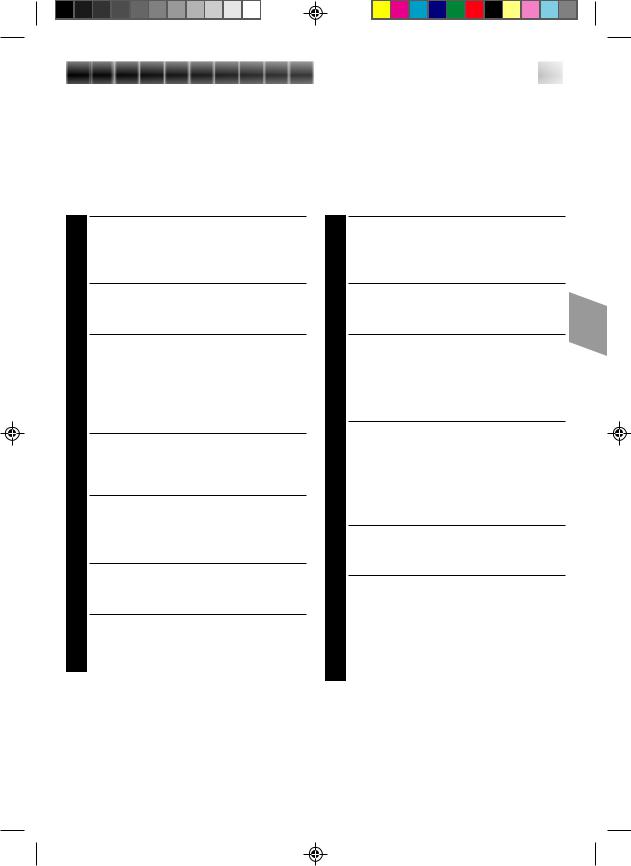
3 and 4 for the desired number of
6 Play back the series of pictures to see if the results were satisfactory.
RELEASE ANIMATION MODE
7 Press REC TIME until “ ” disappears from the viewfinder.
” disappears from the viewfinder.
NOTES:
cFor best results, make sure the camcorder is secured when shooting.
cIf the PROGRAM AE dial is set to Self-Timer mode, Animation is cancelled and Self-Timer mode is engaged with 15S selected.
cFade-in/out cannot be performed during Animation shooting.




 27
27
Time-Lapse
You can record sequentially at preset time spans. Leaving the camcorder aimed at a specific subject, you can record subtle changes over an extended period of time.
NOTE:
You need the optional RM-V20U remote control unit to perform the following procedure.
ENGAGE RECORD–STANDBY MODE
1 Make sure the lens cover is open, then set the power switch to CAMERA.
SET RECORDING SPEED
2 Set SP/EP to SP (Z pg. 11).
SET RECORDING TIME
3 Press REC TIME on the remote control. There are three choices available, and they appear in the following order (each time REC TIME is pressed): 1/4S, 1/2S and 1S. Press again to reset.
SET INTERVAL BETWEEN RECORDINGS
4 Press INTERVAL on the remote control. There are four choices available, and they appear in the following order (each time INTERVAL is pressed): 15S, 30S, 1MIN, and 5MIN. Press again to reset.
START TIME-LAPSE RECORDING
5 Press Recording Start/Stop. Recording and intervals alternate automatically.
RELEASE TIME-LAPSE MODE
6 To release when the tally lamp is not blinking, press INTERVAL and REC TIME repeatedly until “ ” and “
” and “ ” disappear. To release when the tally lamp is blinking, press Recording Start/Stop to stop the blinking, then press INTERVAL and REC TIME repeatedly until “
” disappear. To release when the tally lamp is blinking, press Recording Start/Stop to stop the blinking, then press INTERVAL and REC TIME repeatedly until “ ” and “
” and “ ” disappear.
” disappear.
NOTES:
cFade-in/out cannot be performed during Time-Lapse shooting.
cFor best results, keep the camcorder secured while shooting.
cIf, during steps 3 and 4, the PROGRAM AE dial is set to the Self-Timer mode, the Self-Timer mode is engaged with 15S selected.
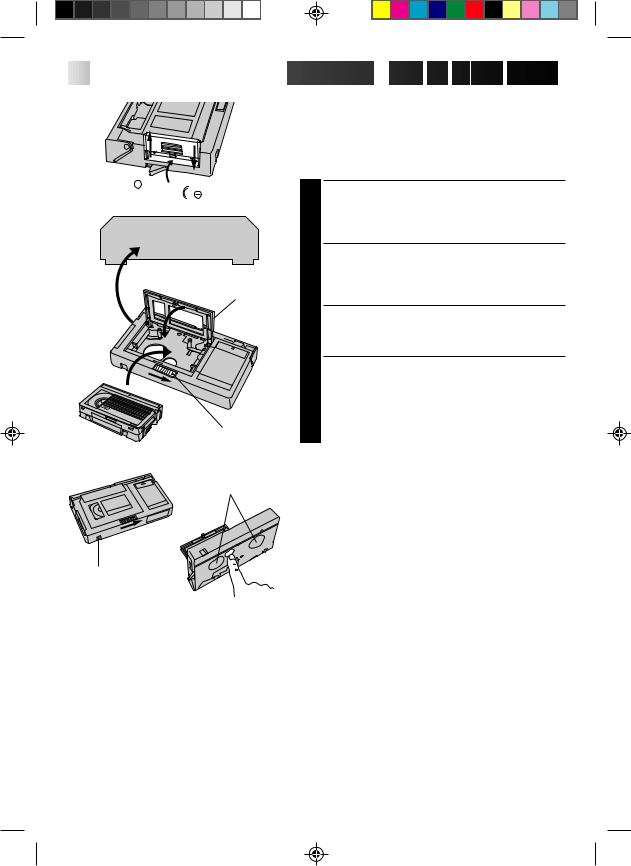
28




































 PLAYBACK
PLAYBACK

 Using
Using The
The Cassette
Cassette Adapter
Adapter
Cassette Adapter (VHS PlayPak)
Use this to play back a VHS-C video cassette recorded with this camcorder. It is fully compatible with any VHS video cassette recorder. The C-P7U adapter is battery powered and automatically performs tape loading and unloading.
+ 
VCR
Compartment door
Sliding latch
Compact video cassette
Reels
Recording safety hole
INSERT BATTERY
1 Slide the battery cover up to remove it, and install one “AA(R6)” size battery as shown in the illustration at left. Then reattach the cover.
INSERT CASSETTE IN ADAPTER
2 Slide the latch to open the adapter compartment door, then insert the cassette and close the compartment door.
PLAY BACK ON CONNECTED VCR
3 Load the cassette adapter into the VCR and play the tape back as you would any other.
REMOVE CASSETTE FROM ADAPTER
4 Slide the latch and the compartment door opens automatically. Then insert your finger in the hole on the underside of the adapter as shown in the illustration at left, push up and remove the cassette.
NOTES:
cDuring tape loading and unloading, do not touch the reels for safety and tape protection.
cDuring special-effect playback (slow motion, still frame, etc.), the picture may vibrate or noise bars may appear on the screen.
cTo record on a VCR using a compact cassette and the adapter, cover the adapter’s recording safety hole with adhesive tape.
